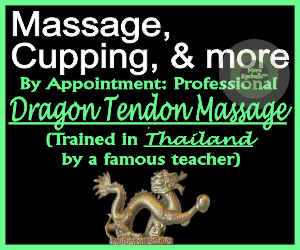- Joined
- Aug 8, 2009
- Messages
- 1,414
- Reaction score
- 962
- Points
- 113
Yes, you know that voluntary certification has now been available for 21 months. And that certification, for which you pay $150, allows you to practice anywhere in California. However, according to our information, you have so far not chosen to be among the 28,000 massage therapists to apply for CAMTC certification.
What you may not realize are two things:
What’s the deal on cities requiring certification? Cities are permitted to keep their existing massage therapy regulations in force; they just can’t require a city massage license from anyone who possesses CAMTC certification. Some cities have decided, rather than continue to be involved with issuing massage licenses or permits, they will simplify their lives by simply requiring all massage therapists who wish to practice in their city to obtain CAMTC certification.
So far, only a modest number of cities have taken this step, but cities trade notes, and this approach offers budget savings at a time when municipal finances are stressed. ABMP does not know whether this trend will become pervasive, but it well could.
If you choose not to become CAMTC certified, you should at least realize there are possible risks to your future ability to practice. For example, if next year your city decides to require massage practitioners to become CAMTC certified and you have fewer than 250 hours of massage education at a single approved school, you won’t be immediately eligible to qualify. You will either have to go back to school, move your business to another city, or quit practicing. Please keep this potential scenario in mind as you consider your options.
OK, I’m willing to consider becoming certified. How do I start? To explore your options, first calculate your total hours of documented education. Then see this overview for details on what pathways to CAMTC certification as a Certified Massage Practitioner or a Conditionally Certified Massage practitioner are available to you. (Additional options are available to most therapists who have 500 or more hours of massage education. More about your situation later.)
If you have 250 hours or fewer:
If you have completed 250 hours of massage education, all at a single approved school listed here and at least 100 of those hours are in specified subject areas (anatomy, physiology, contraindications, health and hygiene, business, and ethics), then you likely will qualify to become a Certified Massage Practitioner through Portal A on the overview chart.
If you don’t have 250 hours of massage education at a single approved school, but do have at least 100 hours of massage education from such an approved school, you may qualify for Certified Massage Practitioner via Portal B or Portal C. However, these routes, which require demonstrable experience providing massages, have daunting documentation requirements.
A simpler approach for individuals who have at least 100 hours of massage education from one of the schools on the above referenced list (or from most schools located in other states) is to pursue conditional certification via Portal E. You will either need to arrange for your school to send evidence to CAMTC that you completed those education hours or to be able to give CAMTC transcripts or other course completion documentation that appears sufficiently persuasive in cases where your school is no longer in operation. This pathway to Conditionally Certified Massage Practitioner will expire at the end of 2011. The earlier you apply, the better.
In order to maintain your Conditional Certification as a Massage Practitioner (CCMP, Portal E), you will be required to provide evidence of securing a minimum of 30 hours of continuing massage education each year, until your total massage education hours total 250 hours. You must meet the 250-hour total within 5 years after the date you are granted CCMP status.
Once you have completed a minimum of 250 hours of massage education, you may apply for an upgrade to Certified Massage Practitioner (CMP). You may apply for the upgrade at the time you reach 250 hours or at the time of your next renewal.
If you have between 250–500 hours:
You can apply for CMP (Portal A) certification if you have between 250 and 500 documented hours including at least 100 hours in specified subject areas (anatomy, physiology, contraindications, health and hygiene, business, and ethics) from a single approved school. This pathway will expire on Jan 1, 2015.
We anticipate that many ABMP members will have a tough time meeting this standard, as member hours often come from different short programs and continuing education. If you have enough hours, but your education was obtained from more than one school, there are three practical solutions:
You will likely qualify for Certified Massage Therapist (CMT) certification. Continuing education counts if you can document it. At least 250 hours of the total 500 hours must come from an approved school or schools.
Once you are CAMTC certified at the CMP level, you can qualify for an upgrade to the CMT level with continuing education hours. No one is required by state law to be certified, so the fact that 28,000 people have already applied indicates, at the very least, a perceived benefit of CAMTC certification. Don’t wait to apply if you are a qualified massage therapist who has been working with less than 250 hours of education.
PLEASE, do not be intimidated by the process of applying for CAMTC certification. More than 28,000 of your fellow massage professionals have applied and nearly 90% of those applying have been, or will be approved for certification.
What you may not realize are two things:
- Some cities are now requiring CAMTC certification
- For several thousand ABMP members, your window of eligibility to apply for certification will close on December 31, 2011
What’s the deal on cities requiring certification? Cities are permitted to keep their existing massage therapy regulations in force; they just can’t require a city massage license from anyone who possesses CAMTC certification. Some cities have decided, rather than continue to be involved with issuing massage licenses or permits, they will simplify their lives by simply requiring all massage therapists who wish to practice in their city to obtain CAMTC certification.
So far, only a modest number of cities have taken this step, but cities trade notes, and this approach offers budget savings at a time when municipal finances are stressed. ABMP does not know whether this trend will become pervasive, but it well could.
If you choose not to become CAMTC certified, you should at least realize there are possible risks to your future ability to practice. For example, if next year your city decides to require massage practitioners to become CAMTC certified and you have fewer than 250 hours of massage education at a single approved school, you won’t be immediately eligible to qualify. You will either have to go back to school, move your business to another city, or quit practicing. Please keep this potential scenario in mind as you consider your options.
OK, I’m willing to consider becoming certified. How do I start? To explore your options, first calculate your total hours of documented education. Then see this overview for details on what pathways to CAMTC certification as a Certified Massage Practitioner or a Conditionally Certified Massage practitioner are available to you. (Additional options are available to most therapists who have 500 or more hours of massage education. More about your situation later.)
If you have 250 hours or fewer:
If you have completed 250 hours of massage education, all at a single approved school listed here and at least 100 of those hours are in specified subject areas (anatomy, physiology, contraindications, health and hygiene, business, and ethics), then you likely will qualify to become a Certified Massage Practitioner through Portal A on the overview chart.
If you don’t have 250 hours of massage education at a single approved school, but do have at least 100 hours of massage education from such an approved school, you may qualify for Certified Massage Practitioner via Portal B or Portal C. However, these routes, which require demonstrable experience providing massages, have daunting documentation requirements.
A simpler approach for individuals who have at least 100 hours of massage education from one of the schools on the above referenced list (or from most schools located in other states) is to pursue conditional certification via Portal E. You will either need to arrange for your school to send evidence to CAMTC that you completed those education hours or to be able to give CAMTC transcripts or other course completion documentation that appears sufficiently persuasive in cases where your school is no longer in operation. This pathway to Conditionally Certified Massage Practitioner will expire at the end of 2011. The earlier you apply, the better.
In order to maintain your Conditional Certification as a Massage Practitioner (CCMP, Portal E), you will be required to provide evidence of securing a minimum of 30 hours of continuing massage education each year, until your total massage education hours total 250 hours. You must meet the 250-hour total within 5 years after the date you are granted CCMP status.
Once you have completed a minimum of 250 hours of massage education, you may apply for an upgrade to Certified Massage Practitioner (CMP). You may apply for the upgrade at the time you reach 250 hours or at the time of your next renewal.
If you have between 250–500 hours:
You can apply for CMP (Portal A) certification if you have between 250 and 500 documented hours including at least 100 hours in specified subject areas (anatomy, physiology, contraindications, health and hygiene, business, and ethics) from a single approved school. This pathway will expire on Jan 1, 2015.
We anticipate that many ABMP members will have a tough time meeting this standard, as member hours often come from different short programs and continuing education. If you have enough hours, but your education was obtained from more than one school, there are three practical solutions:
- Apply for CCMP (Portal E).
- Or, complete a 100-249 hour program at an approved school. This will give you the necessary single-school hours in specified courses and, when added to your previous education, will also boost you over the 250-hour mark. Then apply for CCMP (Portal E) and use your extra hours to upgrade immediately to CMP.
- Or, obtain additional courses so your total education is at least 500 hours. Then apply for Certified Massage Therapist through Portal F.
You will likely qualify for Certified Massage Therapist (CMT) certification. Continuing education counts if you can document it. At least 250 hours of the total 500 hours must come from an approved school or schools.
Once you are CAMTC certified at the CMP level, you can qualify for an upgrade to the CMT level with continuing education hours. No one is required by state law to be certified, so the fact that 28,000 people have already applied indicates, at the very least, a perceived benefit of CAMTC certification. Don’t wait to apply if you are a qualified massage therapist who has been working with less than 250 hours of education.
PLEASE, do not be intimidated by the process of applying for CAMTC certification. More than 28,000 of your fellow massage professionals have applied and nearly 90% of those applying have been, or will be approved for certification.




































































































